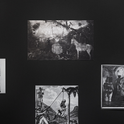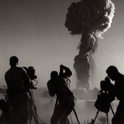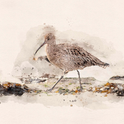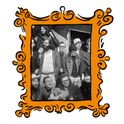Brighton, 21st February 2022, 6.14pm: collar up against the wintry cold, I am leaning on the rail of the Palace Pier, watching the salmon-pink sun emerge beneath the cloudbank that is hugging the horizon and instantly begin melting into the sea. All around, the air crackles with the chatter of innumerable starlings. To the delight of those of us gathered there for the best of all end-of-the-pier shows, great airborne rivers of the birds are converging and splitting apart, abruptly changing direction, approaching us and receding, breaking on an invisible shore in mesmerising, shape-shifting waves.
A “murmuration” of starlings is undoubtedly one of the great spectacles of the natural world. But how do thousands upon thousands of birds avoid colliding with each other? How do they collaborate to move in unison like a single supra-organism? These are the kinds of questions Italian Nobel prize-winning physicist Giorgio Parisi set out to answer after being as awestruck as I was in Brighton by the sight of starlings in the skies above his native Rome. And it is with this story that he begins this slim collection of beautifully crafted essays on the wonder of complex systems.
When Parisi became interested in starling murmurations, there was no shortage of photographs and videos of the phenomenon. But all of them merely captured the motion of the birds projected on to the two-dimensional plane of the sky. Parisi realised that, in order to penetrate the secrets of such aerobatic displays, it would be necessary to first determine the trajectories of individual starlings in three dimensions.
With this aim, Parisi and his colleagues in 2005 set up cameras on the Palazzo Massimo, the home of the Museo Nazionale Romano, whose roof overlooks Termini Station Square, one of the starlings’ favourite roosts. It was just before the advent of really high-quality consumer video cameras, so the researchers used two still-cameras rigged to take a photograph 10 times a second. Just as the seven centimetres between your eyes enables your brain to deduce depth information, the 25-metre separation between the cameras enabled the scientists to determine the positions of two starlings several hundred metres away within an accuracy of 10 centimetres. It was precise enough to distinguish birds flying about a metre apart from each other.
After almost two years of work, Parisi’s team was in possession of the first three-dimensional images of groups of starlings. Among the things they discovered was that flocks are actually like flattened disks. Consequently, the rapid changes in their shape and density are mere artefacts of changes in the orientation of the disk with respect to an observer: viewed flat-on, the disk appears large and round, whereas viewed from the side, it appears distinctly thin.
Each starling also behaves like a car on a motorway, maintaining a greater distance between itself and birds immediately in front and behind than it does between itself and birds on either side. And, contrary to expectations, the location where the birds are packed at their densest is not at the centre of the flock but at its edges. Parisi likens it to the entrance of a bus, which is the most crowded place because it is where there are both passengers gathering to disembark and passengers wanting to continue the journey. For starlings, however, bunching is more serious than for bus passengers. It is literally a matter of life and death. The closer together the starlings, the harder it is for a predator such as a peregrine falcon to pick one off.
For Parisi, starling murmurations are just one of the myriad ways in which complexity emerges from simple rules—or, to put it another way, how grand, labyrinthine structures arise from the interaction of basic building blocks. In physics—and Parisi is a theoretical physicist, not a zoologist—those blocks are electrons, atoms, molecules and even the “spins” of the microscopic magnets associated with electrons, atoms and molecules. The striking thing, Parisi points out, is how an increase in the number of components of a system results in a change that is not just quantitative but qualitative. “More is different”, as another Nobel winner, the American Philip Anderson, put it pithily in the title of an essay in 1972. It is the prediction and understanding of such qualitative changes that is the theme of In a Flight of Starlings.
Parisi’s particular fascination has been with “phase transitions”. These happen when there is a profound change in the large-scale properties of a material at, for instance, a particular temperature. A common example is liquid water freezing into a solid at one temperature and boiling into vapour at another. Why such transitions should occur at such precise temperatures when there appears to be no obvious difference between the molecules at a degree away from the threshold and at the threshold itself has been a longstanding puzzle. Teasing out how the interaction of countless microscopic molecules results in a phase transition of the macroscopic bulk is not a million miles away from determining how the interaction between individual starlings creates a murmuration.
One of the characteristics of phase transitions, says Parisi, is that, when viewed with the right theoretical lens, they have universal properties and so are equally applicable in diverse fields of physics. This is their power. If you identify a system similar to the one you already understand, says Parisi, all the machinery used to understand it transfers over automatically and progress is quickly made. For instance, the Higgs mechanism, which endows matter with mass, turns out to be a type of “superconductivity”—a phenomenon in which an electric current flows without resistance. But rather than superconductivity of a solid, such as metal, says Parisi, it is superconductivity of the “quantum vacuum”.
It was for his key role in understanding phase transitions that the Italian won the 2021 Nobel prize in physics. The transitions in question were in a class of materials called “spin glasses”. At a phase transition, they change from innumerable tiny magnets in frenetic motion to innumerable atoms in mindbogglingly sluggish motion. The word “glass” is used to describe them because glass is famous for being a (sort of) liquid that flows at a speed so slow and difficult to discern over human lifespans that the material appears, to all intents and purposes, solid.
Parisi uses his own intellectual journey—his work on starling murmurations and spin glasses—as a springboard to discuss more general and philosophical topics, such as the process of doing science and the source of scientific intuition. He is a particular admirer of Galileo, who, in order to make sense of the world, created a “model” of motion so slimmed-down that even friction, without which you would slip and slide and be unable to walk, did not apply. This type of abstract model, capturing one or more essential features of the world while ignoring everything else, has served science extremely well. Today’s heir to Galileo’s replica of the world is the “standard model” of particle physics; the high-water mark of 350 years of physics, it describes the fundamental building blocks of matter and the fundamental forces that glue them together.
Each starling behaves like a car on a motorway, maintaining a greater distance between itself and the birds immediately in front and behind
Wondering where scientific hypotheses come from, Parisi examines his own scientific intuition. And he echoes something I remember Richard Feynman saying, rather mysteriously, in a lecture I attended years ago as a physics student at the California Institute of Technology in Pasadena: “You can know more than you can ever prove.” Theoretical physicists and mathematicians first have an intuition about a result. Only then do they attempt to construct sequences of logical reasoning to prove it.
Experimental physicists are guided by intuition, too. Parisi cites the example of Enrico Fermi discovering that slowed-down neutrons are more effective than fast neutrons at inducing radioactive events such as nuclear chain reactions. Fermi discovered this when, on impulse, he replaced a lead brick that was shielding a source of neutrons with a brick made of paraffin—and heard a Geiger counter click a hundred times faster. The hydrogen nuclei in paraffin slow neutrons that collide with them, but, crucially, do not absorb them as the nuclei of lead do.
Parisi speculates that such scientific intuition comes from the unconscious. Language is a relatively recent thing and humans may have used a non-verbal means of reasoning for hundreds of thousands of years. Consequently, he says, there is a lot going on in the brain at a non-verbal level before a sentence is actualised or theoretical result postulated.
It is an explanation of intuition that feels a little like the London Underground’s: “Trains are delayed because intervals are occurring”—which leaves Tube passengers shaking their heads and none the wiser. But this is nit-picking. Parisi’s book is an erudite contemplation on both science and the process of doing science. And a joy to read.















